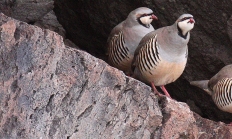
Search myodfw.com
When it comes to turkey hunting from a ground blind, popup blinds are ideal. Popup blinds set up in minutes and are easy to move around. You also can construct a blind from natural materials, but it’s time consuming and you can’t take the blind with you to your next hunting location. The best blind for you One-person popup blinds are small and portable, but there’s not much room to move. Unless a bird approaches and stops directly in front of you, you may not get a shot. The best blind for most turkey hunters is a larger, two-person, 360º








Features: Both males and females have a bluish bill with a black tip. Drakes are white on the top of the head, green eye stripes, purplish breast and flanks, white belly and wing covert patch, and have an iridescent black/green speculum. The grayish hen shows white on the wing covert patch. Habitat: An abundant overwintering duck, especially in the Willamette Valley and coastal areas. Prefer shallow habitats like wet meadows or marshes where, like geese, they feed on green grass and sedges. Techniques: These ducks are early migrants (September) but can be common in mixed duck bags throughout the season

Features: Drakes have a reddish head and neck; black breast, lower back and tail coverts; nearly white back, flank, and belly, and dark gray tail. The hen is grayish brown with a darker brown head, neck, breast and tail coverts. Canvasbacks are large; adults in good condition are as heavy as mallards and second in size only to the white-winged scoter among common Oregon ducks. Habitat: Brackish estuarine bays and marshes with abundant submerged aquatic vegetation and invertebrates are ideal wintering habitat for canvasbacks. Techniques: Generally part of a mixed duck bag. These ducks have a reputation as good table

Features: Drakes are easily distinguished from American wigeon drakes by a reddish brown head, gray flank, and lack of green eye stripe. Hens are similar to American wigeon hens and difficult to distinguish. The call of the male is a shrill whistling, whe'e you; the female's voice a low purr or croak. It is a rare to uncommon visitant east of the Cascades.


Features: Drakes show graceful patterns of black and white plumage, glossy purple heads, white crescent-shaped patches between the eye and bill, steep forehead, and short bill. Females and juveniles have a chocolate-brown head, slate-gray back, wings and tail; adult females have a golden bill. Habitat: Not common, but usually scattered on lakes, reservoirs and coastal estuaries. They share Snake River habitat with the common goldeneye. Techniques: Not usually targeted, they are a rare part of a mixed duck bag.

Features: The winter males' body is mostly white except for a black breast and central back; the wings are dark, scapulars long and gray, and the dark central tail feathers are long and slender. Winter females are darker above with a light head; scapulars and tail feathers are short and dark. Dark areas mark females' heads and males' necks. Habitat: Long-tailed ducks can show up almost anywhere from the coast (they usually winter off shore) to inland on the Columbia River and on lakes throughout the state. Techniques: Some long-tailed ducks are taken in Oregon, but not enough to show


Features: Males have white sides and breasts, deep green heads and dark backs. The pearl gray bodies and white breasts of females, subadults, and eclipse males are sharply delineated from their full-crested chestnut heads. Habitat: During the winter, these ducks are wide-spread in rivers, lakes and marshes across the state. Techniques: Not usually sought for table fare.

Features: The male has a striking black head with a white crest, white breast, black back, and chestnut sides. Females and immatures are dull grayish brown except for a reddish-brown crest. Habitat: During migration hooded mergansers are widespread, though uncommon, across Oregon. They are usually in sheltered areas of lakes and ponds and less commonly on estuaries. Often seem in pairs or small groups. Techniques: Not usually targeted, they can be part of a mixed duck bag.

Features: Males have a ragged-crested, dark green head, a reddish-brown breast, a dark back and gray sides. Females share the ragged crest; their rufous heads and gray bodies may make it hard to tell them from female common mergansers. Their bills, however, are noticeably slimmer. Habitat: Red-breasted mergansers are common from fall through spring, mostly in coastal bays and estuaries but occasionally on the open ocean. Techniques: Their preferred habitat within dangerous ocean waters makes them inaccessible to hunters.

Features: The pintail is an elegant long-necked duck. The long-tailed, full-plumaged drake is striking with a chestnut head, gray back and flanks, bright white breast and front of neck, and iridescent green-bronze speculum. The brown hen is nondescript, but shares the long neck and graceful shape of the drake. Both have a blue-gray bill. Habitat: Pintails prefer the open habitats of sheet water fields and large marshes or ponds. They are a puddle or dabbling duck and usually feed by dabbling or dipping rather than submerging. It is a rare breeder but an abundant fall migrant statewide and one of

Features: The other "greenhead", the drake is handsome with a dark iridescent green head, white breast, reddish belly, blue wing patch of coverts, and an iridescent green speculum. Brown hens also have blue wing patches similar to that of the cinnamon and blue-wing teal. Habitat: This dabbling duck prefers lakes and ponds where it uses its unique bill to sift through water in shallow areas. Food choices include the seeds of sedges, bulrushes and other aquatic plants, duck weed, and algae; also aquatic insects, mollusks and crustaceans. Common winter species in the Willamette Valley and Columbia Basin, but widespread throughout

